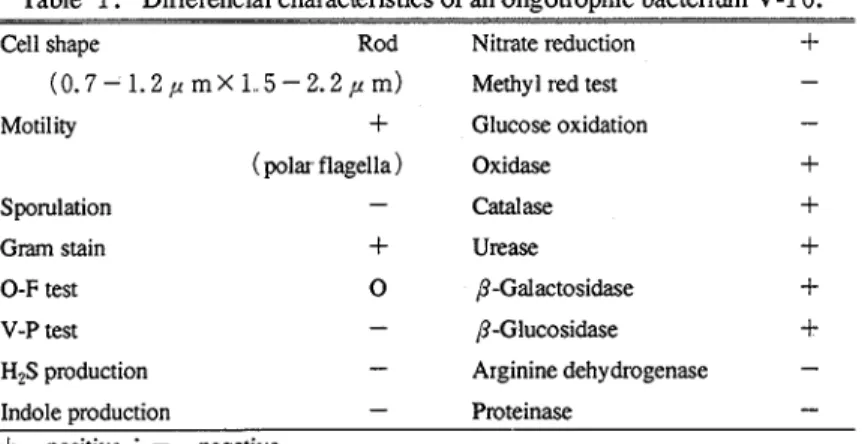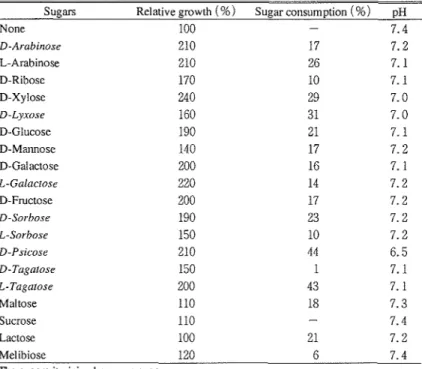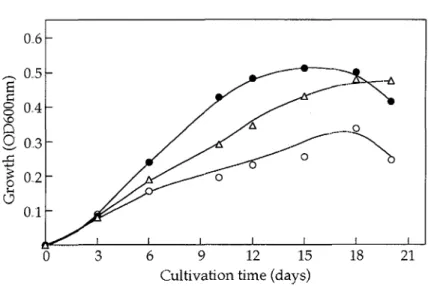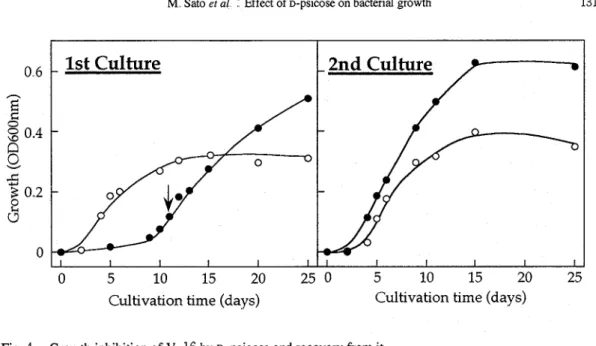EFFECT OF A RARE SUGAR, D-PSICOSE ON GROWTH OF
AN OLIGOTROPHIC BACTERIUM
V-16
Masayuki SATO,
Makimi ISHII,
Yoshio
KIMURA,and
K e nIZUMORI
Summary
An oligotrophic bacterium, V- 1 6, which was a gram positive rod, grew twice well by supplement with a rare keto-hexose, D -psicose, as well as L -tagatose and D -sorbose in 100- fold diluted nutrient broth as a
basal medium The organism utilized about 44 % of the supplemented D -psicose for growth carbon
source in the diluted basal medium But the growth of V-16 was remarkably inhibited by the supplement of D - psicose in higher concentrations of basal media during early cultivation term After the about 10
days cultivation the growth recovered from the inhibition by D -psicose
The organism is not useful for bacterial source for D -psicose metabolic enzymes, because it is difficult
to obtain abundantly cells capable of inducing these enzymes with as small amount of D -psicose as possi- ble
Key words 1 rare sugar, D -psicose, bacterial growth, oligotroph
Introduction
Although rare sugars are rarely distributed in nature, there are some bacteria capable of utilizing various rare sugars in soil. (
'
)L -Sorbose and D -tagatose of rare keto-hexoses have been reported to be utilized by some bacteria (2' 3' 4' 5 ' But little is known of the microbial utilization of D -psicose, L -tagatose and D-
sorbose of rare keto-hexoses Therefore, metabolism of these rare keto-hexoses in bacteria is a subject of considerable interest.
An oligotrophic isolate,
V-1 6,
is one of a few bacteria capable of utilizing D -psicose ('
) We, therefore, examined the effect of D -psicose on growth ofV-16
D- Psicose stimulated the growth ofV-16
in lower concentrations of basal media, but inhibited the growth in the higher concentrations of the basalsMaterials and Methods
Organisms. The bacteria,
V-1 6,
was isolated from the vineyard soil in Kagawa university farm.. This isolate can grow in the 10,000- fold diluted nutrient broth, but can not in the standard nutrient broth.. Thisorganism, therefore, should be called an obligate oligotrophic bacterium. ( 6 )
Media and cultivation.. The 100- fold diluted solution of nutrient broth ( N B ) ( ' ) was used as a basal
medium for growth of V-1
6.
The synthetic medium ( 6 ) was also used for the growth inhibition examination.. The seed culture,0.1
ml, ofV-16
was inoculated into 10 ml of the basal medium supplemented with 0.1
%
of D -psicose or other sugars and incubated statically at
27
"C
for 10 days or longer..test was done using a cytochrome-oxidase reagent (Nissui Co ) Catalase was tested by dripping a
3
%H2 O2 solution on the collected cells Sporulation was checked by Synder's staining and heat treatment at 85"Cfor 10 min (') The 100-fold diluted NB supplemented with
0.008
% bromothymol blue,0.2
% agar, and1 . 0
% glucose was used for oxidation-fermentation test Culture for nitrate reduction test was done using N B /100
supplemented with0.1
% NaN03 API20
NEkit (MERIEUX S. A ) was also used for the other biochemical properties of the isolate. Cells were observed with a transmission electron microscope(Hitachi, H-7
100
).
Assay methods. The degree of bacterial growth was estimated by measuring the optical density of the
cultures at
600
nrn with light length of5
cm or1
cm The amount of reducing sugars in the cultures was estimated by the method of Nelson-Somogyi ( )Chemicals. D -Psicose and D
-
tagatose were synthesized from galactitol by microbial transformationreaction. ( l o '
"
'
Other sugars were purchased from Sigma Chemical Company Agar noble and yeast extract were purchased from Difco Laboratories All other chemicals were obtained from Wako Pure Chemical In- dustr y, Japan and were reagent gradeResults
Characteristics of the isolate, V-16.
Differencial characteristics of the isolate,
V-16,
are shown in Table1
.
The organism was a gram positive oligotrophic bacterium. The three oligotrophic bacteria characterized previously in our laboratory were gram negative and were identified togenera Aeromonas and Chrornobacterrum ( I 2 ) TheV-16
cells grown in NB/
100
were rods possessing a single polar flagella (Fig.1
) Chemical taxonomical properties ofV-16
were not examined Therefore, the isolate was not identified.Utilization of natural and rare sugars
The isolate,
V-16,
was grown in NB/100
supplemented with0.1
% of each sugar for10
days. As shown in Table2 ,
this organism grew well in the media supplemented with every one of fifteen mono-sac- charides without regard to rare or natural sugars, but not so well in the media with four di-saccharides It was worth noting that this organism consumed more than40
% of the supplemented D -psicose and L -tagatose The pH value of the culture supplemented with D -psicose after the10
days cultivation was6 .
5,
while pH values of those supplemented with the others were7.
1
-
7.4.
Table
1.
Diffesencial characteristics of an oligotrophic bacteriumV-16.
Cell shape Rod Nitrate reduction
+
( 0 . 7 - 1 . 2 p m X 1 . . 5 - 2 . 2 ~ m ) Methyl red test -
Motility
+
Glucose oxidation -(polar flagella) Oxidase
Sporulation - Catalase
Gram stain 0-F test V-P test
H,S production
-
Arginine dehydragenase-
Indole ~roduction
-
Proteinase-
Fig.
1.
Electron micrograph of an isolateV-16.
Magnification was6,000.
The bar indicates1
pm
.
Table
2
.
Utilization of rare and natural sugars byV-16
in 100-fold diluted NB. Sugars Relative growth (%) Sugar consumption (%) pHNone 100 - 7.4 D-Arabinose L-Arabinose D-Ribose D-Xylose D-Lyxose D-Glucose D-Mannose D-Galactose L-Galactose D-Fructose D-Sorbose L-Sorbose D-Psicose D-Tagatose L-Tagatose Maltose Sucrose Lactose Melibiose 120 6 7.4
The sugars itaricized are rare sugars.
Growth stimulation by D -psicose and L-tagatose.
Figure
2
shows the growth curves ofV-16
in N B /100
supplemented with0 . 1
% of D -psicose and L - tagatose. The growth was stimulated by the supplement of these rare koto-hexoses, and the peaks of growth were observed after15
-
18
days. Only when D -psicose was supplemented, pH value of the culture fluid was significantly depressed at latter term of the cultivation.Growth inhibition by D-psicose in higher concentrations of basal media.
The isolate,
V-1 6,
grew well still in2.
5-fold diluted of NB medium. Then the effect of the supplement of0. 1
% D -psicose on the growth of this organism was examined when concentrations of the basal medium were higher than NB/
100.
In addition, the effect of the D -psicose was also examined using the synthetic media as basal in which the concentrations of amino acids, vitamins, and nucleic acids were higher than thoseCultivation time (days)
Fig.
2.
Growth ofV-16
in1
/lo0
nutrient broth (NB ) supplemented with D-psicose and L-tagatoseThe organism,
V-16,
was grown in1
/lo0
NB supplemented with0.1
% of D-psicose( 0 )
,
L-tagatose (A) and none(0)
11100 1/50 1/10 115 1 20 40 80
Dilution of NB m e d i u m Relative concentration of organic components
2
0
Fig
3 .
Effect of D-psicose on growth ofV-16
in various concentrations of basal media.The organism,
V-16,
was grown in various concentrations of NB medium and the synthetic medium supplemented with0.1
% of D-psicose ( ) or without it(0)
for10
daysof the standard medium As shown in Fig
3
,
D -psicose stimulated the growth in NB/
50,
NB/
100
and in the standard synthetic medium, but significantly inhibited that in20
-
80-
fold higher concentrations of these organic nutrient mixtures in the synthetic medium as well as in NB/
10
and NB/
5
Recovery from the growth inhibition by D -psicose
When the isolate was incubated in NB/
10
supplemented with0. 1
% D -psicose, the growth was in- hibited during the earlyer cultivation and began after about10
days, and after25
days the relative growth was160
% to that in non-supplemented NB/
10
( ~4
i).
~The cells of 11 days age in the first culture sup--
NB medium
-
-
o 1 0 -Synthetic medium
--
020 h-
- 0 1 52
a
w w0
- 0 1 06
38
- 0 0 5Cultivation time (days)
Cultivation time (days)
Fig.
4 .
Growth inhibition ofV-16
by D-psicose and recovery from itThe organism,
V-16,
was grown in1
/lo
NB supplemented with 0.1 % of D-psicose(a)
or without it(0)
The cells (+) of 11 days age in thelst D-psicose culture were inoculated into the fresh media for the 2nd culture.plemented with D -psicose were inoculated in the fresh media for the second cultures In the second cultures, the cells grew more in the medium supplemented with D -psicose than in the non-supplemented medium
( ~ i g .
4
).
Utilization of D- psicose by resting cells reaction
In order to obtain efficiently much cells utilizing D-psicose with as small amount of it as possible, we tested utilization of D -psicose by resting cells reaction. But under the reaction conditions tested the resting cells of
V-16
consumed only a few percent of initial amount of D -psicoseDiscussion
The isolate,
V-16,
is an interesting bacteria with regard to utilization of rare keto-hexoses such as D-
psicose, L
-
tagatose and D -sorbose (Table2
),
because these rare sugars have never been reported to be utilized for bacterial growth In rat, D -psicose metabolism was reported ( l 3 ) In order to study the metabolic enzymes of these rare sugars in bacteria, it is preferable that cells capable of utilizing such sugars are prepared enough in mass. Then we tried to obtain much growth ofV-16
in higher concentrations of the basal medium However, the growth ofV-16
was remarkably inhibited by the supplement with D -psicose to the nutrient richbasal media ( ~ i g .
3
).
And after the about ten days cultivation the growth ofV-16
recovered from the inhibi- tion by D -psicose (Fig.4
).
The mechanism of the growth inhibition by D -psicose and the recovery from it will be future subjectsWe wish to investigate the bacterial metabolic enzymes of D -psicose, L -tagatose and D
-
sorbose However, the oligotrophic isolate,V-16,
is not useful for a bacterial source of these enzymes, because it is difficult to obtain abundantly cells to induce these enzymes with as small amount of the substrates as possible.References
( 1 ) SAID, M , ISHII, M , KIMURA, Y , and IZUMORI.K
.
Evaluation of ability of soil bacteria to utilize rare sugars. J Gen Appl Mtcrobiol , 4 1, 181-
184 ( 1995).
( 2 ) BISSETT, D. L., and ANDERSON, R L ' Lactose and
D -galactose metabolism in Staphylococcus aureu P
I11 Purification and properties of D-tagatose-6- phosphate kinase. J Btol Chem , 255, 8745 - 8749 ( 1980 )
.
( 3 ) HOSHINO, T , SUGISAWA, T , TAZOE, M , and F'IJJIwARA, A
:
Metabolic pathway for 2 -keto-L-gulonic( 7 ) CONN, H J
,
BARTHOLOMEW, J W , and JENNISON, M W:
Staining methods In Manual of microbiological methods p 10. McGraw-Hill Book Co , New York( 1957 )
( 8 ) SYNDER, A M ' A modification of the dorner
spore stains Stain Techno1 , 9 , 71 ( 1934 ) ( 9 ) NELSON, N. ' A photometric adaptation of the
Somogyi method for the determination of glucose
I Biol Chem , 153, 375 - 380 ( 1944 )
.
(10) IZUMORI, K , MIYOSHI, T , TOKUDA, S , andYAMABE, K.
:
Production of D-tagatose from acid formation in Gluconobacter melanogenus IF0 dulcitol by Arthrobacter globiformzs Appl Environ3293. Agric Biol C h e m , 54, 1211 - 1218 Mtcrobtol , 46, 1055 - 1057 ( 1984 )
(1990). (11) IZUMORI, k , YAMAKITA, M , TUMURA, T , and ( 4 ) KELKER, N E , SIMIKINS, R A , and ANDERSON, R KOBAYASHI, H
:
Production of D-psicose from DL
:
Pathway of L-sorbose metabolism in Aerobacter -talitol, D-tagatose of ~-galactitoi by Alcaligenes spaerogenes J Btol C h e m , 247, 1479
-
1483 701B. J Ferment Bioeng , 70, 26 - 29 ( 1990 ).
(1972).
( 12) KIMURA, Y,
UENO, Y , KAJIKAWA, K , NAKAMURA,( 5 ) S u ~ n o , T.
.
A novel enzyme, tagatose kinase, from Mycobacterium butyricum Biochtm BtophysActa, 660, 366
-
370 ( 1981 ).
( 6 ) SATY), M , UENO, Y , SAWAMURA, Y , KAJIKAWA, K , KIMuRA, Y
,
YOKOYAMA, K , and IZUMORI, K.
Growth inhibition of obligately oligotrophic soil bacteria by carbohydrates, amino acids and vitamins Tech Bull Fac Agric Kagawa Univ ,45, 31-40 (1993).T , and SAIO, M ' Physiological characteristics of
three oligotrophic soil bacteria, Aeromonas sp. Y26,
Ae~omonas sp 206, and Chromobacterium sp Y
95, in low concentration of nutrient broth Bull Jnp
Soc Microbial Eco , 10, 21-29 ( 1995)
.
( 13 ) WHISTRLER, R L , SINGH, P P , and LAKE, W. C:
D-Psicose metabolism in the rat Carbohydr Res ,
34, 200



